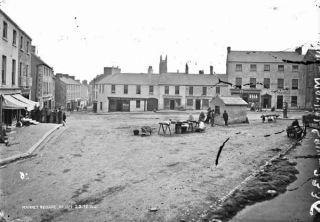Market Square
Navan's Market Square has been the hub of the town for many centuries.
Below are some views of the Square over the years, the top four probably from the end of the 19th century early 20th century. The one one with the bus is St. Patrick's Day 1954 with the Silver Band out in force, and the more recent ones are from 2007 and 2011 respectively.
The Market Cross (which dated from c. 1585) once stood on the spot occupied in succession by a weighing shed, a pump and a telephone kiosk. It was uprooted during Penal times. A fragment of it is now on display in the Solstice Arts Centre.
|
t
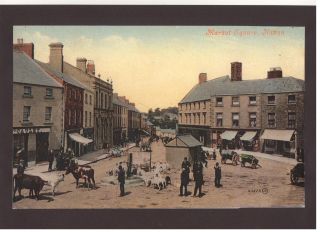 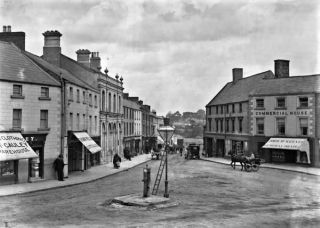 Market Square late 19th century
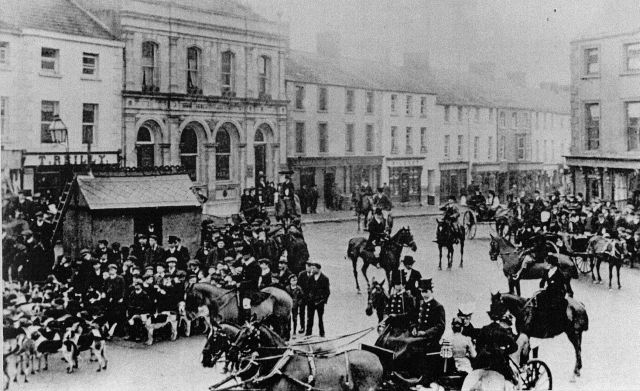 The Hunt in the Square
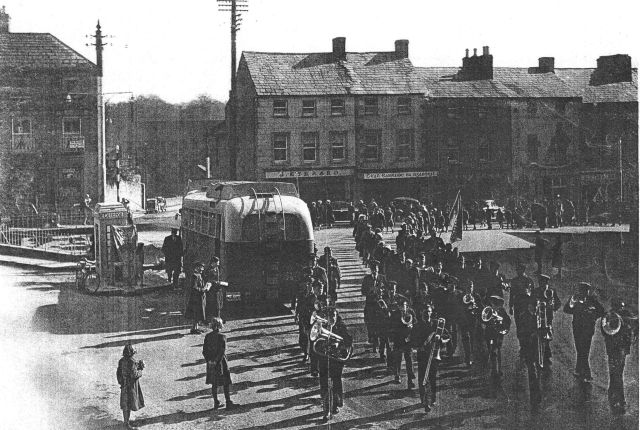 St. Patrick's Day 1954 The Silver Band in the Square
 Market Square, 2007 Photo: © N&DHS
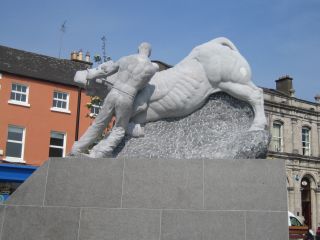 Market Square, 2011 Photo: © N&DHS
Navan was a noted commercial and market centre from the 17th century onwards. Here in the Square a weekly market was held which was supplied with vast numbers of bacon, hogs and porkers, butter in large quantities and country merchandise in great abundance.
The town was the corn depot of Meath.There was a stone cross in the centre of Market Square. All buying and selling was done in the vicinity of the cross. For many years, all funerals through the town carried the coffin around the area where the cross stood. The location of the Market Cross is where the pump is situated in the photo 2nd from the top above.
Navan still has the characteristics of a typical Norman town, which consists of three streets meeting together at a market square. The three streets are still intact. Trimgate, Watergate and Ludlow St. which was once called Dublingate meet at the Market Square.
*******
The squalor of the town in the late 19th century elicited the following editorial from the locally produced Meath People:
"The Market Square has some kind of attention given to it by the officers of the Town Commissioners, and owing to their fortunate situation other portions keep themselves: for on the one side, the flood sweeps away everything from the Post Office to Mrs Morans, and on the other, there is an all purifying torrent from Mr Nicholas Russells to the bridge over the Blackwater.
But traverse Trimgate St. or Academy St. not to speak of the minor streets, lanes and alleys and you have the accumulated filth of all the higher parts of the town as well as of their own natural creation.
It is a literal fact that from the Commons Road down to the Railway Bridge there are fully two inches of horse manure, saturated hay and sludge of every description, covering the streets from one side to the other to the great enjoyment of pigs and geese, but to the wrongful inconvenience of those who are necessitated to tread up on it - for no one walks out who can possibly keep within doors.
In minor streets there is a dung heap at every door as a matter of course, and the leading ones - drays and jaunting cars with springs down and shafts up - have their nightly stands opposite the houses of their respective owners."
*******
Another Navan Protest (1918)
Another great demonstration of protest against the British Government's proposal to enforce conscription in Ireland was held in Navan. The public were wholly unaware of the intention to hold the meeting, until it was announced from the altars of the churches in the county on Sunday morning: but even at such short notice a gathering of upwards of 5000 people assembled in the Market Square from practically all parts of Meath.
Source: The Meath Chronicle Centenary, Publication p. 87
*******
Market Square in the 1940's
[This information was compiled by Frank Lynch (postman) from Finian's Tce.]
1. John Smyth's Shoe Shop / Finnegan's Betting Shop
2. Brady's Tea Room and Pub.
3. Delaney's Newsagent
Metges Lane: Martin's Guest House / Shane MacNamee Radio and Television / Sheridan's Builders Yard at end of lane.
4. Miss Pollard, Ladies Hairdressers,
5. John Smith's Shoe Shop
6. Flood's Ice Cream Parlour
7. Bob, Bobby and peter Byrne Hairdresser
8. McCawley's Shoe Shop / Michael McDonagh Radios, TVs, Bicycles.
9. Reilly's Butchers / T. Clowry Butcher
10. Reilly's Private Residence (passway between butcher and pub)
11. Pat Smyth's Pub.
12. Hibernian Bank
13. Meath Chronicle Stationary Shop
14. Miss Davis Ladies Wear
15. McKeevers Drapery / Melville's Drapery / Maloccas Cafe
16. Steps to Health Chemist
17. Everards Pub.
18. Loughran & Woods Ladies Wear
19. Owens, (delivered milk throughout the town)
20. Mattie Loughran, Butcher
21. Spicer's Bakery Shop
22. Munster & Leinster Bank
23. Crinion's Central Hotel
24. Fitzsimons Grocery and Pub
25. McEvoy's Pub (since 1873)
26. Conaty Bicycle Shop / Michael Dunne Hardware
27. Keappock's Fish & Vegetable Shop
Old Cornmarket: In this area Padian & Finnegan's Betting Shops / UDC Weigh Bridge / Gussie Curtis' Forge.
*******
The Market Square in 2004
Nos 1 & 2 Market Sq.(2004) Rebuilt in 2004 reasonably similar to what it looked like
formerly. It was JL Finnegan, Bookie, and Kealy and Walsh Grocers. There was a pub
at the back. Nina McKenna had the first hairdressers in Navan upstairs.
No. 3 Market Sq. (2004): Newsagent. Was run for many years as a newsagents by Peter Delany and Gerry Delaney. No. 4 Market Sq.(2004): Navan Safety. This was the family home of Steens. Ambrose Steen was the state solicitor. There was a long garden, which stretched back as far as the multi- story car park. It had a tennis court and cricket was played in the garden. The Steens were noted for looking after injured and shell shocked World War 1 veterans among whom there were Captain Bigtoe, Petes Cahill and Petes Mullen. Later it was occupied by Shane MacNamidhe and family.
No. 5 Market Sq. (2004) Holly’s Kitchen. This was John Smith, Boot and Shoe shop. No. 6 Market Sq. (2004): Stanley Racing. Pat Flood had a café called The Soda Fountain. No. 7 Market Sq. (2004): The Flower Stand. Robert Byrne had a Barber's Shop here. No. 8 Market Sq. (2004): Reilly Estates. This was McCauley shoes followed by Kelly and McDonagh electrical.
No. 9 Market Sq. 2004: Sullivan Property Consultants. This was Reilly, Butchers followed by Tommy Clowry, Butcher. Reillys had a house on the lane beside the shop. No. 10 Market Sq. (2004): Smyths Pub. This pub is in the Smyth family for over seventy years. No. 11 Market Sq. (2004): Bank of Ireland. It was built as the Hibernian Bank. Nos. 12 & 13 Market Sq. (2004)
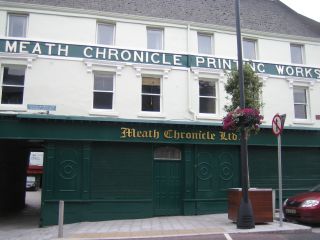 The Meath Chronicle Ltd. is here for over a century.
The Davis family who owned the paper lived at No. 12.
Maura Davis had a Lady’s Shop in No 13
on the right of the premises.
(right) Meath Chronicle 2011
No. 14 Market Sq. (2004): ACC Bank. Thomas J. McKeever had a drapery shop.
No 15 is signed on this building which is not correct.
Photo: © Navan & District Historical Society
No. 15 Market Sq. (2004): ACC Bank. This was the location of Timmons Apothecary known as Steps to Health. No. 16 Market Sq.(2004): Everards Pub. Bridget Teresa Everard had a Pub and Grocery which passed to her nephew Willie Curry; now run by his son Jim Curry. No. 17 Market Sq. (2004): Green Chilli restaurant. Pat Loughran had a Ladies Drapery under the name Loughran and Woods. No. 18 Market Sq ( 2004): Martinas. Alice Owens had a shop that sold milk and delph. No. 19 Market Sq. (2004): Bon Appetit. Matthew Loughran had a butchers shop. He sponsored a banner which was strung across the street for religious processions
and was always referred to afterwards by the title of the banner – The Lamb of God.
No. 20 Market Sq (2004): Coopers. It was Spicer’s bread shop. No. 21 Market Sq. (2004) Clonard House. This was the Munster and Leinster Bank. No. 22 Market Sq. (2004): St. Laurence. It was Crinion's Central Hotel with Grocery and Bar on the left side. No. 23 Market Sq. (2004): The Square Pint. This was Bennett’s pub which can be identified on an old photograph and was subsequently owned by Pat Fitzsimons who was a chairman of Meath County Council.
No. 24 Market Sq. (2004): John McEvoy. Originally a pub, Patrick McEvoy bought this premises in 1873 and it has been in McEvoy family ownership ever since. Today it deals in small household goods. No. 25 Market Sq. (2004): Phone Shop. Peter and Henry Conaty had a bicycle shop here. No. 26 Market Sq. (2004) Irish Nationwide. Joseph Keappock had a fish shop and his sister Eileen sold sweep tickets. *******
Excavations Market Square, 2003
http://www.excavations.ie/report/2003/Meath/0010472/
County: Meath Site name: 22 Market Square, Navan Excavations.ie number: 2003:1435 License number: 03E1493 Author: Stuart D. Elder, The Archaeology Company, Birr Technology Centre, Mill Island, Birr, Co. Offaly. Site type: Urban ITM: E 686980m, N 767810m Latitude, Longitude (decimal degrees): 53.652824, -6.684252 Testing was undertaken on the site of a proposed hotel and nightclub redevelopment, extending from behind No. 22 Market Square, Navan (a protected structure), towards Church Hill. The requirement for testing was part of a further information request from Navan Town Council, which made specific reference to the impact of the development on the suspected line of the medieval town wall. The site had been cleared of most of the standing structures and demolition debris prior to excavation of the trenches, but a standing building to the extreme south end of the site precluded testing in this location. To the north of the development site, another standing structure and demolition debris precluded testing up to the rear of the protected structure. The discovery of a basement in the central area of the site also precluded testing in this location. Despite these restrictions, three long north-south trenches and a short east-west trench were opened across the site. During testing, two wall foundations were discovered towards the southern end of the site, in Trenches 3 and 4, and a possible rubbish pit was noted in Trench 1, at the western side of the site. A programme of monitoring or testing was recommended for all groundworks not covered by the testing programme at the southern entrance and the north-eastern part of the site.
*******
Market Square How times have changed . . . . the old Market Square in Navan in the early part of this century when it was known as the Market Place. A note taken from a book of the era on the town reads: “Navan has the queer distinction of being about the only important place in Ireland whose name in English, spells the same “backward and forward.” It is one of the most ancient towns of the royal county of Meath, which, with more territory, long since incorporated with other counties of Leinster, once formed a province in itself. The name of Navan would seem to be derived from the Gaelic Eamhuin – pronounced Aven – a great rath, with, according to Professor Joyce, the Irish article “an,” contracterd as usual to “n,” placed before the gaelic name thus: n Eamhuin – the pronunciation of which is exactly represented by Navan. The gigantic rath, a mile and a half west of Armagh, originally spelled in the same manner, is called by the English speaking people of Ulster “Navan Fort,” thus establishing the logical relationship of the names. The town is situated at the junction of the Boyne and Blackwater rivers, about 28 miles northwest of Dublin, and has a fine inland trade. It contains flour, flax and paper mills, a tannery and other comparatively prosperous local industries. The Catholic Seminary, established after the abolition of the penal laws, is one of the best in Ireland. There are also four national schools, a convent school and other educational establishments. A ruin called “St. Kevin’s house” is pointed out in the old part of the town, and there are many relics of antiquity in the neighbourhood.” |
